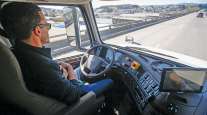Stripes on California Highway to Pave Way for Self-Driving Vehicles

While it likely will be several more years before autonomous vehicles are common on North State roads, Interstate 5 could be a step closer to accommodating the vehicles by this spring.
The California Department of Transportation plans to begin putting 6-inch stripes on I-5 from Orland to the Oregon border during the first half of the year.
The new stripes will replace the old 4-inch ones and will be brighter and more durable than the previous stripes. They’ll enable self-driving vehicles to help “read” the road, according to Caltrans.
RELATED: Paint designed for self-driving vehicles to be tested at autonomous proving ground
Donald Anderson, deputy director for maintenance and operations for Caltrans’ District 2 office in Redding, said the main reason for the wider, brighter stripes, though, is safety.
“As our population is getting older, we are looking at doing what other states have done and providing a 6-inch stripe versus the 4-inch, which gives a much higher illumination and basically a much brighter stripe, especially at night when cars are traveling by it,” Anderson said.
The other purpose is the coming revolution of driverless cars.
“This is one of the products that the autonomous vehicle manufacturers have identified as a product that they could possibly use for directing the vehicles along the state highway,” Anderson said.
While it is not yet legal for consumers to take self-driving vehicles out on the road for a trip to the lake or grocery store, manufacturers are testing them on public roads and highways, said Jaime Garza, a spokesman for the California Department of Motor Vehicles.
So far 50 manufacturers have received permits to test autonomous vehicles, and there are 364 vehicles being tested, Garza said.
Some of the manufacturers include Samsung, Apple Inc., Volkswagen, Ford, BMW, Honda, Roadstar.Ai, Lyft Inc., Jingchi Corp and Tesla Motors.
While one of the registered autonomous vehicles could be spotted cruising down the freeway in the North State during testing, most of the driving is being done in the Bay Area, Garza said.
RELATED: Regulators to seek more input for autonomous vehicle rule revisions
Although a contractor hasn’t yet been chosen, Caltrans estimates the striping will cost about $6.8 million.
The current paint striping fades from vehicle wear and weather, which requires Caltrans to repaint all highway stripes throughout District 2 every year, Anderson said. The district covers an area from Tehama County to the Oregon border and from Humboldt County to the Nevada state line.
While all state highways eventually will be striped with 6-inch lines, only I-5 is set to get the upgraded striping this year, said Lupita Franco, a Caltrans spokeswoman.
The new striping to be installed on I-5 will be more durable than the material currently used, Anderson said. Some of it will be thermoplastic and some of it will be a tape-like material, he said.
The thermoplastic is expected to last two to three years, while the tape is guaranteed by the manufacturer to last five years, Anderson said.
The tape and thermoplastic contain tiny glass beads that help illuminate the stripes, Anderson said.
“The stuff we’re putting down is like 10 times the standard” for brightness, Anderson said.
Distributed by Tribune Content Agency, LLC




